Chilling out with Toru Nogami, creator and CEO of Samurai Jeans.
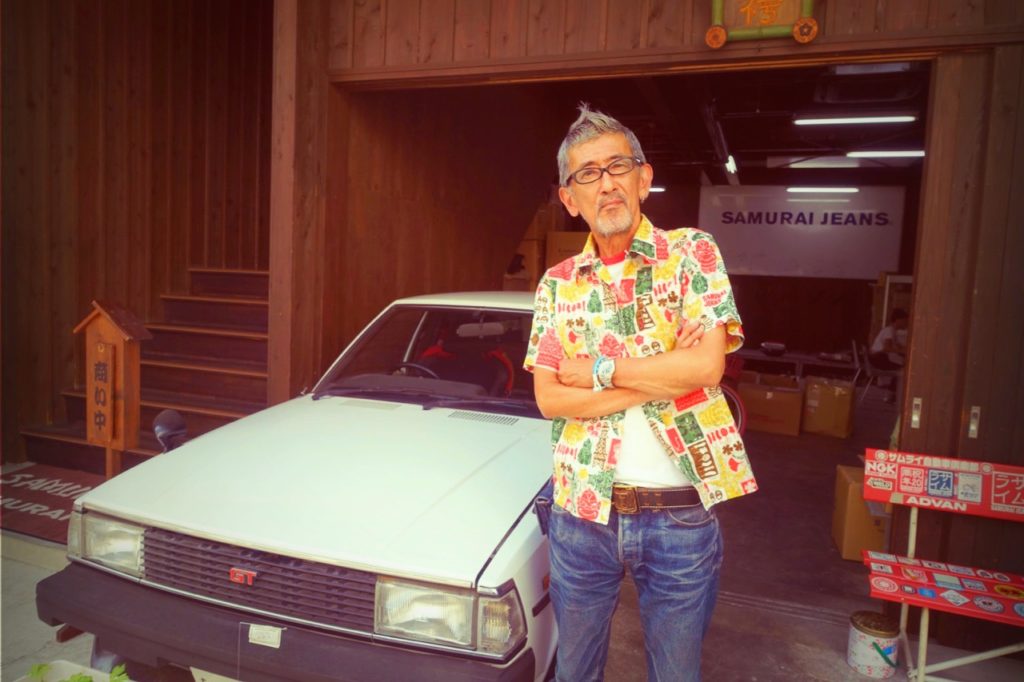
I recently took a drive down to Samurai Jeans headquarters in the Umeda area of Osaka to chat with Samurai Jeans founder, Toru Nogami. Nogami-san created Samurai Jeans in 1997 from very humble beginnings, and his jeans have become well-known around the world for their heavy denims and extreme attention to detail.
The main shop itself is unassuming, and looks very much like a house. I had to in fact ask some local grannies who were furiously gossiping on the corner about two blocks away from Samurai Jeans if they knew where the place was – they didn’t. They did however warn me to take better care of myself on account of the heat and humidity, and admonished me to drink more barley tea. I’m not sure how they were able to accurately gauge a stranger’s hydration levels (I was thirsty), but I thanked them all the same for their concern. Gotta love Japan.
Having found Samurai Jeans only 100 meters removed from said gang of octogenarian do-gooders, I strolled in and found Nogami-san busily working away on a computer. He cut quite a figure with his silver spiked hair, fantastic Samurai aloha shirt, and (what else?) perfectly faded jeans. Another jeans-clad employee quickly produced some freezing cold tea for us to drink, and I politely introduced myself. His relief upon my speaking Japanese was obvious, and he jokingly yelled back into his office that he wouldn’t be needing his bilingual female staff member to wait around anymore. She giggled and said that Nogami-san had wanted her around just in case the foreign guy showed up firing away in English, which is normally the case. Duly relaxed, we sat down and had a good chat.
Just a quick note on translation before we start. Osaka and area has a very colorful dialect, full of slang and fiery local intonation. Viewed as both hilarious and harsh by the rest of Japan, I’ve done my best to convey that in the translation to English. Aside from that, I’ve added nothing, nor taken anything away. I hope you’ll enjoy listening to Nogami-san as much as I did.
Japanalogue: So what made you think to start making jeans on your own? What was the motivation or goal at the beginning?
Well, I loved jeans of course back then…you know, everyone loved Levis in those days and the whole repro thing was going strong here in Japan. We’re talking over 20 years ago now, so there were already a lot of brands making jeans in Japan so…yeah, I knew I was a bit late getting into the game but I wanted to do it anyway, so I just started. There were so many others doing similar things so I knew from the start I wanted to do something different, so to kind of separate myself from the other brands I started right off making heavy 15 oz jeans, which were basically unheard of back then. I know of course other brands like Iron Heart are now known for heavy denim too but…I’m pretty sure we were the first. It just kind of went up from there too, 17, 19, 21 ounces… I mean, after all, jeans are essentially work clothes so I was trying to make them as sturdy and strong as I possibly could, beyond what was just necessary.
And was that here, at the Umeda shop?
No, I started out in Nishinomiya, close to Koshien Stadium, around that area. I had a tiny one-room apartment and I just started right there in that room, making jeans by myself. I moved here to the Osaka location ten years ago and I’ve been here ever since.
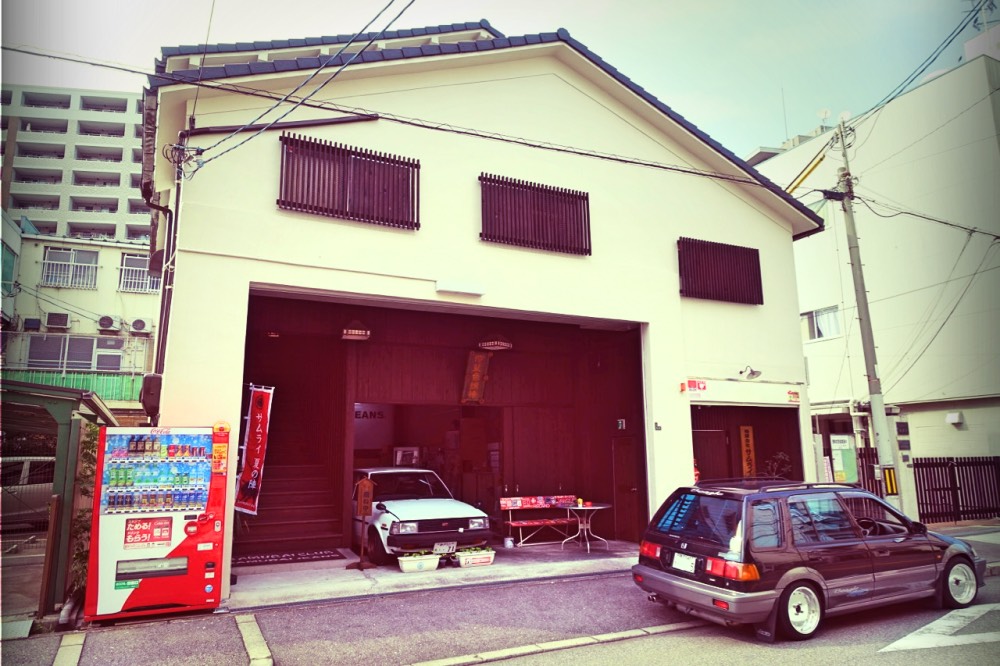
The name Samurai…I mean it’s pretty cool and fits perfectly…where did that come from?
Yeah, it’s like…Japan…Japanese. “Japanese spirit equals samurai” is what I was thinking so…I registered the business as that, Samurai Jeans, over 20 years ago now.
Was it pretty tough at the start? There must have been some setbacks, I mean you’re working there by yourself in a little apartment trying to make jeans…
Well yeah, I mean the making jeans by myself part was hard enough, but the bigger issue was that the idea of “heavy denim” was totally alien to everybody back then. People were like, “Levis were 13.5oz so…isn’t that probably what you should be doing, creating replicas (like everyone else)?” Some were actually like, “What the hell are you even doing? 15 ounces? Why would you do that? Jeans like that will never fade.” I think today you would just call that bashing…(laughs) I was told jeans like mine would never sell so best to stick with making replicas. I get it but…as I was saying before, I wanted to do something different, and that something was to make the denim heavy. I did base the first cuts on vintage Levis design but…I added a good dose of Samurai spice if you know what I mean. And the negative voices got even louder once I moved up to 17, 19, 21 ounces…they just said the same stuff over again. You have to understand that at that time even the threads needed to make this kind of denim didn’t exist, so we had to start right down at that level, going to the people who made thread and trying to explain what it was we wanted. So yeah, everything was from scratch right from even before the thread itself. Making thread and choosing dyes, considering fades and all that…it wasn’t just a simple thing.
Were you satisfied with what you were making back then or did that take time?
Satisfied? No, no,…ha, I’m not even satisfied now! To make jeans that are 100% perfect…I don’t think that’s even possible. Is it possible? From the start I’ve been constantly evaluating, tweaking, improving…it’s not something that people are going to be able to necessarily see with their eyes, and I don’t really go out and tell anybody about it, but that’s what I’m doing…constantly refining. 100% satisfied? Yeah I’m pretty sure I’ll be dead before that happens. And I think even after I’m dead I still won’t be able to do it…(laughs). It’s not so much like an unsatisfied feeling but…I mean it’s actually fun to be constantly improving and coming up with ways to make the jeans better. There’s always something more you can do.
Do most of your ideas for new items, models, fabrics, colors, all that…are they mostly from you or…
Of course there are things that come solely from me, but my staff here is a huge help and they are constantly wearing and testing the stuff we make, commenting, saying what they think, what they want changed…like this needs to be corrected or adjusted, that kind of stuff, how it’s aging. So everybody here at Samurai contributes in that way. Of course we are trying to make things that people who wear and love Samurai will want, but the staff definitely helps with product improvement, development.
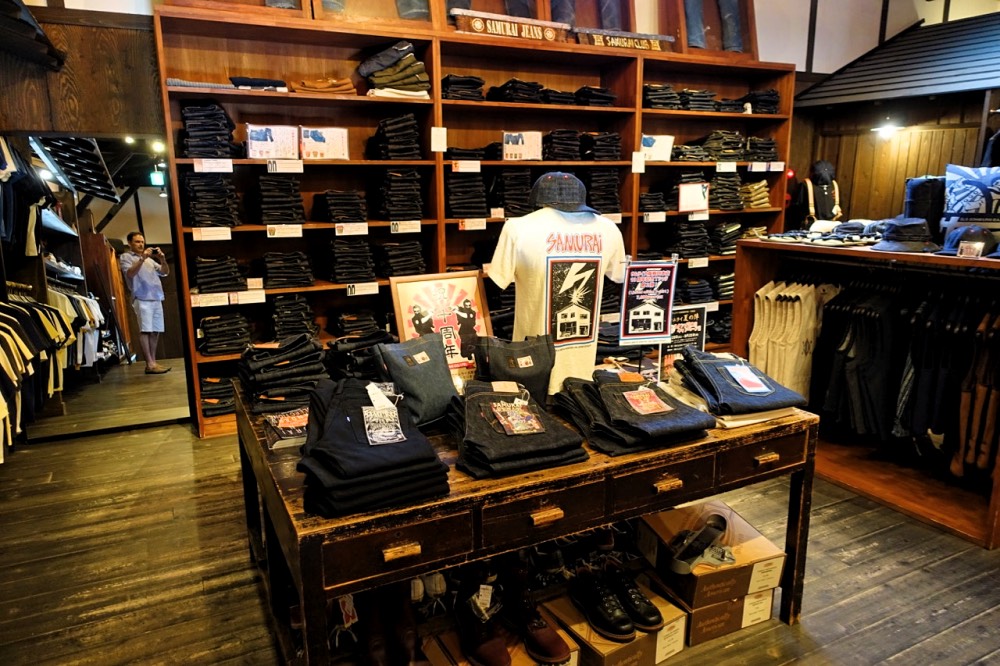
Are there any other Japanese denim brands that you like, or appreciate what they are doing?
Yeah…well…I mean of course all the other brands here that were already doing their thing when I started making jeans…I think they’re all great.
Is there anything in particular that you feel sets Samurai apart from the other jeans out there?
If you mean what’s different about them, then it’s like I was saying: the weight of the denim. I know that now you can now basically go anywhere and lots of companies are doing heavy denim but…back at the start I think it was us that started all of that, probably along with Iron Heart shortly thereafter.
Do you have a favorite personal model of Samurai jeans or favorite denim weight, weave….?
Not really actually. To be honest, I have a certain kind of love for all of them.
I’m not sure if you’re gonna want to answer the next question, but where does your denim actually come from? I mean which mill? I might have heard that Samurai is a bit secretive about all of that…
No, no…I wouldn’t say it’s secret exactly. It’s more that it’s complicated rather than secret…there are the people who make the thread, and then there’s the folks doing the dyeing…and of course the machine shops, the mills. Basically our whole process is not any different from the other Japanese denim brands I don’t think. Of course though, even if the mill was the same, there are still all the things that make each brand or denim different…how loose the weave is, how slubby you make the fabric, the threads and how they were dyed, how heavy you’re going, etc…so yeah, I mean all these variations are the things that make each brand’s denim unique, and you don’t go around talking to everyone about that part, but that’s kind of just how it is. So I guess in that sense there are such things you could call company secrets, but…I think that’s pretty normal.
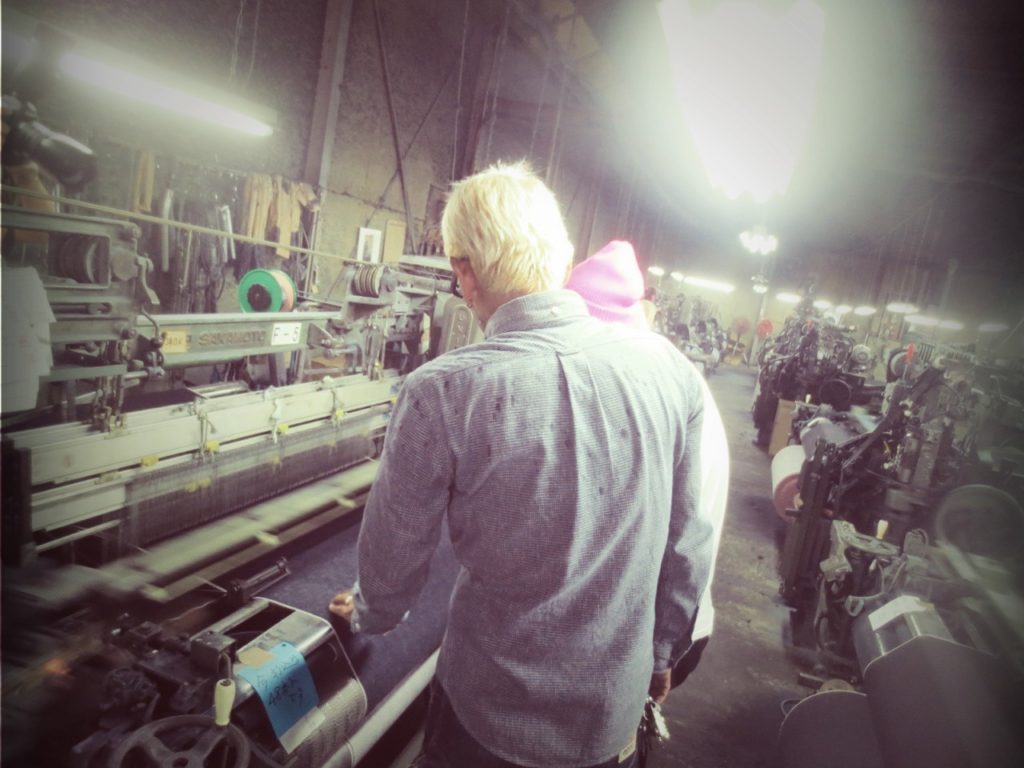
Photo courtesy of Nogami-san.
I get it for sure. I was reading about your Homemade Jeans Project where you guys are planting and harvesting your own cotton…could you tell me a bit about that? It’s basically from seeds to jeans, all in Japan?
We’ve been doing that now for…let’s see…10, 12, maybe 13 years now. You know we were always saying our jeans are “Made in Japan, Made in Japan” but we were all sitting around in the bar one night drinking, talking about how great it is that our jeans are made in Japan when it kind of hit us like…what does that even mean exactly? What is this “Made in Japan” thing we keep saying? I mean in one way it makes sense because we were doing everything in Japan, making jeans from scratch here so…yeah that’s a kind of “Made in Japan” but the more we thought about it, we were like…okay, in reality these jeans are essentially comprised of thread, all of which is imported. If you think of it that way, 99% of the jeans are not from Japan at all, it all comes from somewhere else. Texas, Zimbabwe, China…so how can we honestly say these jeans are 100% made in Japan? That’s what we were thinking that night, pondering over drinks.
Sorry, I’m laughing because I can totally picture it…I think it’s great…
(laughs) And the next thing we thought was, as you can guess, let’s make 100% Made in Japan jeans! Keep in mind we were all drinking during this talk so the next morning we had to kind of regroup and we went out and asked the thread makers if they had any threads that were totally made in Japan, but there weren’t any. So we were then wondering how many things of any type, not just jeans, can you really say are 100% made here? It would have to be like some priceless object made for the Emperor or something, maybe some ultra-high grade silk cloth or something along those lines, some sacred expensive object you can’t really touch or use. I think then we were even more enthusiastic about giving it a go and just decided to do it. As you can imagine, the naysayers started up again, saying there’s no way this scheme would work, but we just thought that, as they say, you’ll never know unless you try. We weren’t going to give up without even giving it a go. That was about 12, 13 years ago. So we got some land and planted the seeds, and tried to grow cotton.
Wow, that’s impressive that you guys would take than on. What happened?
We didn’t get anything. It didn’t work. But slowly, after a lot of messing up, we actually were able to produce a small amount of cotton and then slowly increase that year by year until we could actually create something out of what we harvested. So it was about 4 years ago that we actually…there was like a certifying ceremony they held and we got a big plaque saying that it was, officially 100% Made in Japan, from seed to jeans. We planted the seeds, picked the cotton, had it spun, dyed, woven, and we made the jeans. (pointing at his own jeans)
The ones you have on now? Are those the ones?
No, not these ones, different ones. But we did it. The plaque is up there, in the rafters if you want to see it.
Oh yeah I can see it…it’s huge! Well, congratulations on that…awesome.
Thanks.
And are you guys continuing with that, like trying to increase the yield or…?
We’re definitely still doing it. I’m pretty sure we’re the only jeans brand in the world doing this so it’s quite fun. We’re out there every Saturday along with interested customers that want to help out. I know it’s weird to say something like, “Nobody could copy this” or something like that but…to be honest, this one in particular would be hard for somebody to duplicate. At the very least, even if somebody else did pull it off we could say, “We did it first…you guys were second” (laughs). But seriously, Samurai will keep this project going, at least as long as I’m still around. To be honest though, and realistic, we get such a small amount of cotton from this that…I mean you’ve probably heard that our first groups of jeans made from what we managed to harvest were 1,000,000 yen a pair (about 9000US) and, well obviously, that’s pretty expensive. They were entirely made from the cotton we grew by ourselves but…the cost of doing that…what we do now is instead of making the whole jean with our cotton is we use our own cotton for the warp, but imported cotton for the weft so…I guess they are “half-Japanese” anyway. These ones are about 70,000 yen (about 650US). They have denim that comes from a different year’s harvest so they are labeled like that, by year, each using the previous year’s cotton that we grew. Every April we do it, a regular release. To make heavy denim from materials we grew and then make it into jeans is something special for me…my heart and feeling are really into that. I think maybe even after I’m gone Samurai will keep doing this. In this one thing at least, I don’t think any other brand can match us.
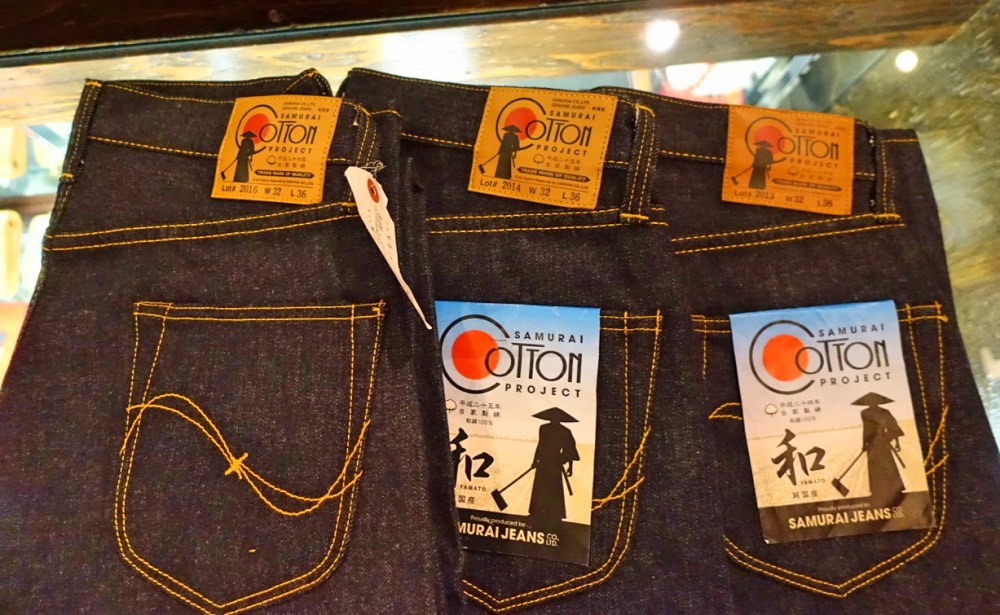
I think that’s…awesome…really fantastic what you guys have going there. Besides the fact that it’s grown here, is the cotton you produce different from what’s normally brought in from overseas?
It is. The cotton fibers themselves are really short compared to the usual imported cotton so even just making thread from it is a big challenge.
And how many pairs of jeans do you figure you can make from one harvest?
Very few…very few. If you’ve ever seen cotton fields in China, Africa, or the States, they’re absolutely massive. We’ve just got a little plot of land. Of course commercial cotton producers also use a lot of agrochemicals and all that kind of stuff so there’s that angle too. We don’t do that. Ours is just organic, natural.
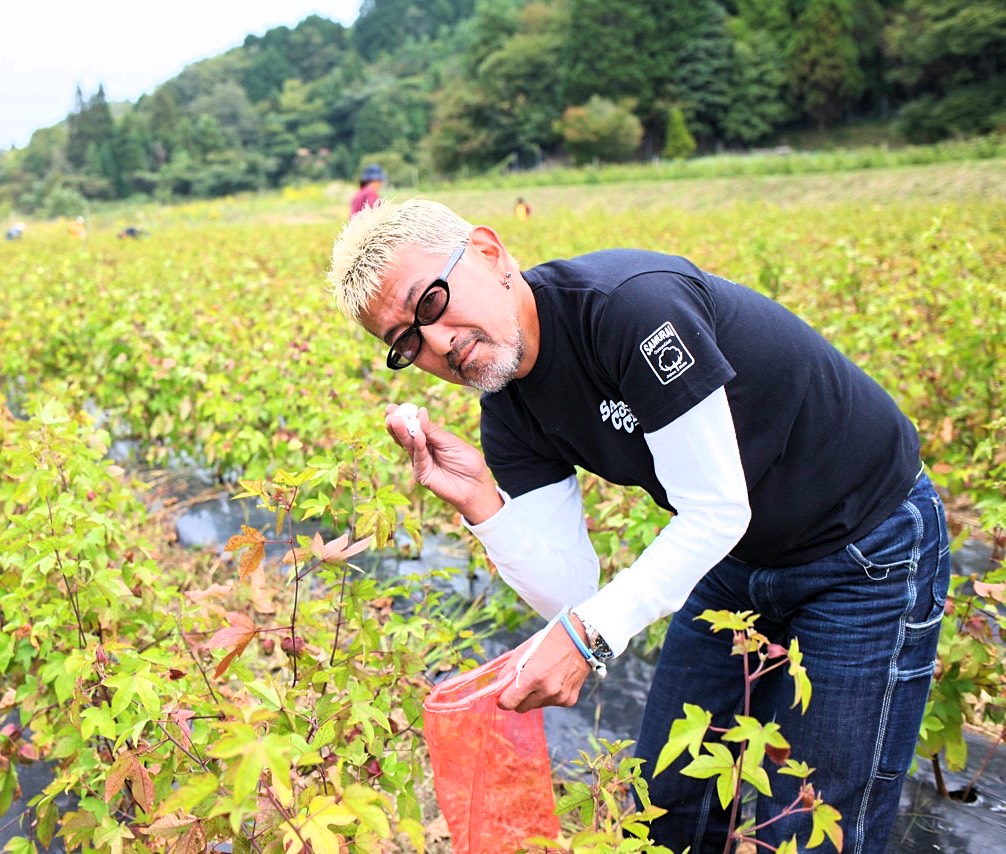
Photo courtesy of Nogami-san.
Changing the subject a bit, do you get a lot of overseas customers coming in here, to the main shop?
Actually, we do, yeah. A lot of Americans these days, and places like Thailand, Hong Kong, Malaysia, Indonesia..southeast Asia seems big lately.
Do have plans to open Samurai shops overseas one day or are you good with how things are now?
Well we do have some select shops overseas selling Samurai, in quite a few countries, so…that seems good for us, for the time being anyway.
What’s the best part about your job?
The best part? Best part? Hmmm…best part…(takes some time to think) It’s actually pretty hard to be honest!
Okay, what’s the toughest part?
Well there are a lot of Samurai fans out there and we want to keep up with what they want, what they expect us to make…and we try to do that, making all different kinds of new things but…it’s not easy to do everything. It’s actually not really possible to keep up with every single request or trend, so you have to take a breather sometimes or you’ll make yourself sick. I don’t mean it’s like a burden or anything like that, I just mean it’s not easy. To be honest though, I actually love it. It’s a great challenge and all I can do is keep moving forward with the jeans, that’s why I’m here.
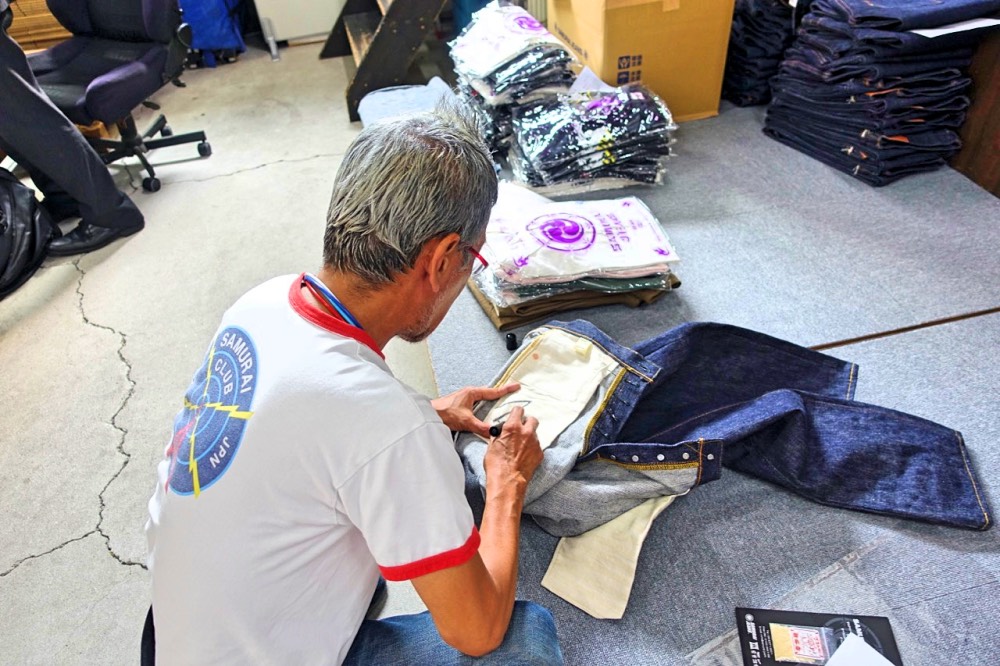
This next one might be tough but how would you describe your own personality?
My personality? Whoa. I wonder that myself actually…hmmm…I guess I’m impatient. I’m not good at waiting for things to happen or being patient. If there’s something I want to do, I want to do it now or I’ll probably just lose interest if I have to wait around. I’m not the kind of person who can just sit there and ponder over something forever, what are the good points, what are the bad points, what should I do…I can’t do that. I can’t just sit still and do nothing.
We often hear about how there might be a shortage of good Japanese selvedge denim in the future, in Okayama I guess…the looms are old, there aren’t enough parts or people to run the looms and fix them, etc. Is this something we should worry about or is it all going to be okay?
Yeah, I know what you mean, but actually I think the mills are taking measures to protect themselves and ensure they’ll be fine in the future, so I don’t think it’s really that big of a worry to be honest. Of course machines eventually break down, but there are still a lot of old machines down there so…they are being smart about it and of course parting out the old looms to keep the new ones running smoothly so…mmmm…I think it’s actually going to be okay, as far as I can see.
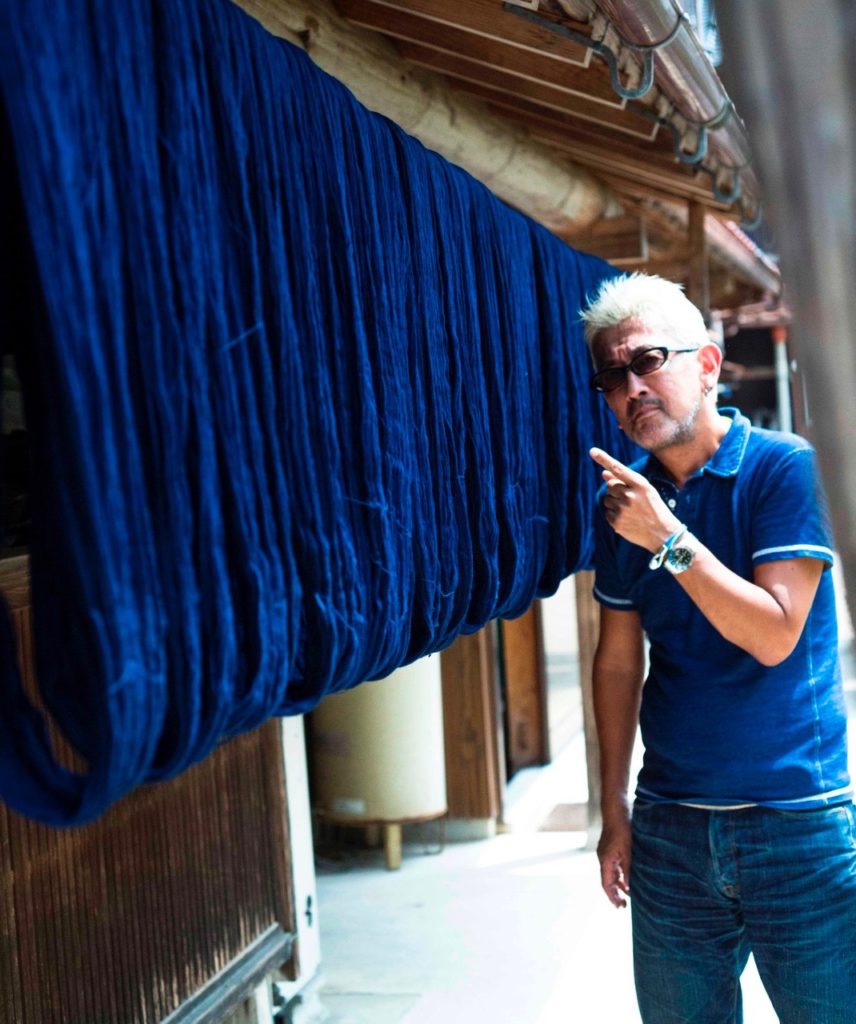
Photo courtesy of Nogami-san.
Well that’s good to hear. I just have maybe 3 or 4 more questions…
Not a problem at all. Only a few more? I could keep talking about jeans for a long time…(smiles)
What are the best points about this city, Osaka. Like when overseas customers come in wanting to know about Osaka or where to go….
Osaka…I’d say good people. A lot of good, kind people here. Warm people…don’t you think so too? I mean…you know the image of Tokyo having maybe…more aloof people…you know, Osaka has a lot of good people and that’s it’s best point.
How about places? Spots to see while you’re here…
Ah, places? Not connected to jeans or what I was just saying, right? You mean just cool places to go and check out?
Yeah, exactly.
It would have to be Minami…Shinsaibashi, wouldn’t it? Tennoji, Tsutenkaku, that area…I’m mean we’re talking deep, deep Osaka now. Down, downtown. You’ve been here a long time…you know what I mean (laughs).
Yeah, yeah, I do actually (laughs). So aside from all of this…this great shop and store and making jeans…what else makes you happy? What do you like to do?
Well, of course jeans and making clothes but…other than that…I love cars. Old cars. Old Japanese cars. Like Haraki-san (owner of Iron Heart) loves bikes, Harleys, I love old cars. I have two vintage Corollas, a 3rd generation and a 4th generation. I love the old Corollas the most.
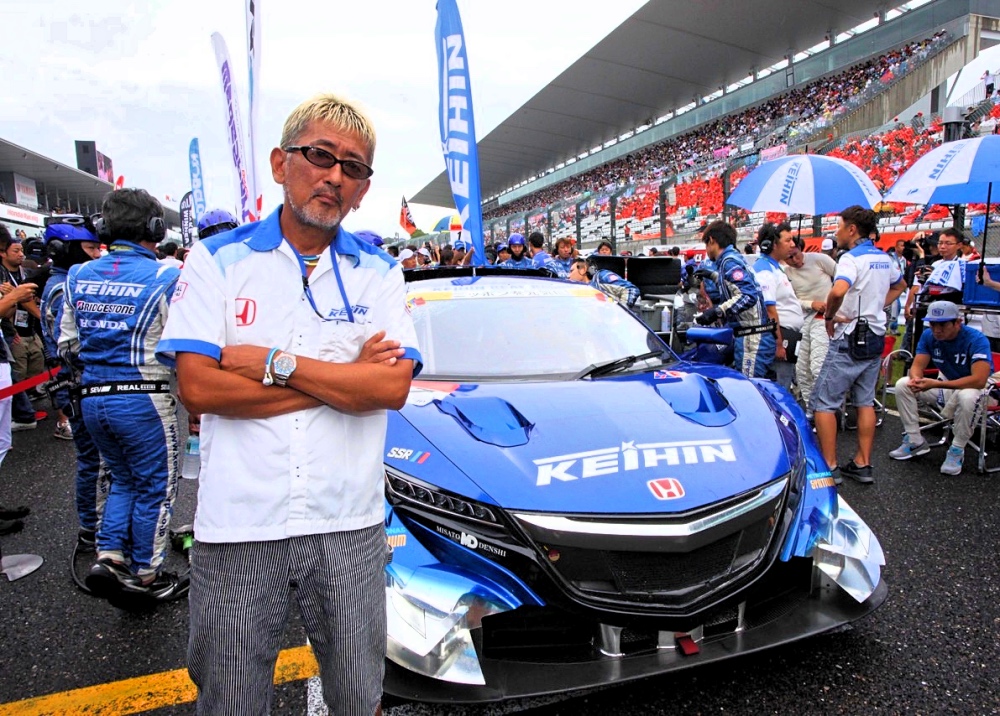
Photo courtesy of Nogami-san.
Lastly, I’m hoping a lot of people who love and wear (or are interested in) Samurai jeans will be reading this. Is there anything else you’d like to say in closing?
Definitely. Firstly it would be just to say thanks to those who wear and enjoy our clothing…and to those thinking about trying out Samurai. It’s just a huge feeling of appreciation first off. And even for people who might not have an interest yet and have never tried our jeans, I invite you to give them a try, feel the quality, see what you think. I just want to say thank you to everybody actually…just appreciation, appreciation, appreciation. And also I know I said earlier that it’s impossible to make 100% perfect jeans, but I’m going to try and do it anyway, for those who love Samurai. Actually can you leave that last sentence kind of open…with a bunch of dots at the end? You know, just in case I’m not actually able to do it? (laughs) But I am going to try my best.
Absolutely, I can do that Nogami-san. Thank you so much for your friendliness and openness – it’s been super interesting talking with you. Do you mind if we head upstairs and check out the shop? I’ve been pretty excited about that…
Of course, of course…but take it easy for a bit first. It’s hot and humid today so just relax and we’ll have some cold tea before we head up.
Read more about Samurai Jeans here.

The man, the legend! Nogami-san!!
legend not born.its created!!
Loved the interview and enjoy the new website.
Excellent interview. Getting a feel for Nogami-san’s authenticity, I’m happy that I love wearing Samurai Jeans so much!
ありがとうごさました
What an impressing interview with a great man. I had a great chat with him too when he was in my Jeansroom a few years ago
Astounding denim journalism! Really admire how you’re forging ahead in a medium you’ve practically created. Appreciate you, my friend.
I have on my own the S710XX21OZ-SY jeans and the SSS21-IK shirt and both are beautiful pieces of clothing 💪🏻